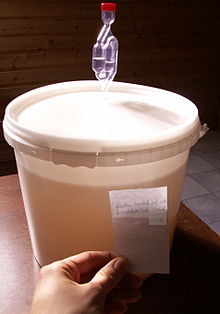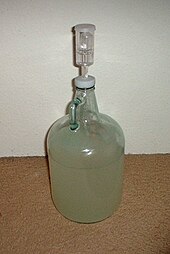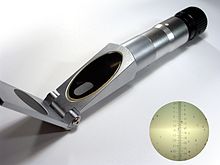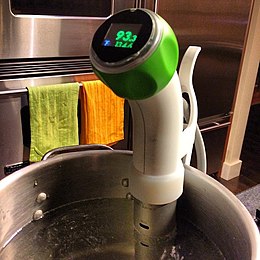Kilju
This article needs additional citations for verification. (December 2015) |

Kilju (Finnish pronunciation: [ˈkilju]) is the Finnish word for home made alcoholic beverage typically made of sugar, yeast, and water.
The ABV is around 15–17%, and since it does not contain a sweet reserve it is completely dry. Crude fermented water may be distilled to moonshine. Kilju for consumption is clarified to avoid wine fault, it is a flax-colored liquid with no discernible taste other than that of ethanol; an alcoholic beverage used as an ethanol base for drink mixers.
Cultural aspects[edit]
Kilju is considered to be a low-quality beverage that is consumed mainly for the sake of its alcohol content. It is commonly associated with the punk subculture.[1]
Due to its low cost, potential wine fault (when not clarified enough), and simple production process, kilju is mostly drunk by low-income people.
Kilju is a well-established part of the Finnish alcohol and counter-culture, as witnessed even in the leading engineer school's making-and-use-of video of yore. "Four thousand litres of gases are generated. They are led to the neighbours' delight." The drink tends to invite such black humour, of the deadpan kind.
The first commercially produced kilju was introduced in 2022.[2][3]
Production[edit]

The process is similar to that of homebrewing wine. If done slowly, it requires rigorous hygiene and filtering of the product. If brewed fast, specialized dried yeasts are available in amounts to drive the fermentation process through before bacterial infiltration can take place, in about three days. In Finnish the latter are called pikahiiva (lit. quick-yeast), and they are sold in about a hundred gramme packs dry, as opposed to the live standard pack of brewer's yeast of 50g wet.
Properly made kilju is a clear, colorless or off-white liquid with no discernible taste other than that of ethanol. It can be produced by natural settling of the yeast over time, but nowadays various fining agents are used to hasten the process as well.
Kilju is often produced improperly by home brewers who allow contaminants to disrupt fermentation or do not adequately filter or rack the liquid, or do not use a fining agent. The latter mistakes result in yeast being suspended, causing the mixture to be cloudy rather than clear. The yeast is not harmful, but can yield an unpleasant taste and intestinal discomfort.[citation needed] It is also a common mistake to leave the carbon dioxide produced by fermentation into the suspension, so that the yeast provides it with nucleation sites, keeping the yeast up in the solution. Proper technique calls for airing the product after fermentation, stirring, and perhaps for fining agents such as microsilica or various semipolar proteinaceacous or carbohydrate agents.
Ingredients[edit]
An easy way to produce fermented water is to obtain turbo yeast kits (contains Saccharomyces cerevisiae yeast strain, enzymes, vitamins, and minerals) that instructs on the package the quantity of white sugar, and tap water needed.
- Inverted sugar syrup
- Water
- Sugars in wine: White sugar (or crystallized sucrose) is cheap and common. Also, partial refined sugar like brown sugar should be avoided, for example molasses produces a distinct flavor in rum. Using plain sugar is beneficial over whole fruit; Methanol is a major occurrence in fruit spirits.[4]
- Yeast in winemaking: The most common yeast associated with winemaking is Saccharomyces cerevisiae. Saccharomyces cerevisiae is excellent at producing ethanol.[5] Yeast are dependent on a few nutrients (often included in yeast kit sanchets) to produce as much ethanol as possible, the most important ones are:
- Invertase is an enzyme that cleaves the glycosidic linkage between the glucose and fructose molecules in sucrose. This helps the yeast metabolize the sugars faster.
- Thiamine: Increases the resistance of the yeast Saccharomyces cerevisiae against oxidative, osmotic and thermal stress.[6]
- Yeast assimilable nitrogen (YAN), is the combination of free amino nitrogen (FAN), ammonia (NH3) and ammonium (NH4+) that is available for the wine yeast Saccharomyces cerevisiae to use during fermentation. Outside the sugars in wine, nitrogen is the most important nutrient needed to carry out a successful fermentation that doesn't end prior to the intended point of dryness or sees the development of off-odors and related wine faults.
Inverted sugar syrup[edit]
Inverted sugar syrup for fermented water is usually home-made by fully dissolving sugar in cold tap water. Yeast requires oxygen rich water that do not exceed 25 degrees Celsius.
A common manual way to dissolve refined sugar is to mix with water in a container which is half filled, and then sealed and shaken. However, a mixer or blender may be used to automatically dissolve the sugar, in turns, if necessary.
Yeast[edit]
Yeast, and yeast nutrition, is mixed in the syrup. One gram pure yeast consumes approximately 0.2 grams sugar.
Yeasts will usually die out once the alcohol level reaches about 15% due to the toxicity of alcohol on the yeast cells' physiology while the more alcohol tolerant Saccharomyces species take over. In addition to S. cerevisiae, Saccharomyces bayanus is a species of yeast that can tolerate alcohol levels of 17–20%.[7]
Alcohol measurement[edit]

- To make plain crude kilju, the must weight must be zero: A fermentation lock should indicate less than a bubble per minute. Then the sugar reserve is measured with a must weight refractometer/hygrometer. If there's sugar left, then more yeast should be added to consume it, and this measurement process should be repeated. A solution with sugar is not fermented water, but fermented syrup.
- Clarification: The solution is clarified, typically with a fining agent like bentonite.
- Alcohol by volume: Only when the must weight is zero, and when the solution has been clarified, an alcoholic hydrometer, or an ethanol-type refractometer, will display accurate alcohol volume. A leftover sugar reserve will give false values.
Alcohol adjustment[edit]
Since fermented water contains no flavors, water may be added to cut down the ABV if desired.
Post-process[edit]

Fermented water contains a similar alcoholic content of wines as both beverages are fermented on yeast, however fermented water differs from wine and other fermented beverages in that it contains no fruit juice or residual sugar after manufacture.
Kilju can be produced by fermenting sugar, yeast, and water, but it was illegal in Finland before March 2018;[8] therefore, grain, potatoes, fruits[9] or berries were used during fermentation to avoid legal problems and to flavor the drink. Oranges and lemons are a popular choice for this purpose.
Undistilled[edit]
Flavoring[edit]
It often has additives such as citrus fruits, apples, berry juices, or artificial flavorings. Flavored kilju from fruits for example doesn't necessarily have to be sweet as long as all sugar is consumed by the yeast.
Kilju (15-17% ABV) contains 2.4-2.7 times more water than 40% distilled spirit. Since kilju contains approximately 85% water, it can be mixed with concentrates like a drink mixer, fruit syrup, or squash concentrate.
Carbonation (alcopop)[edit]
Alternatively, it can be made as a carbonated soft drink by two methods.
When served before the fermentation process is complete. Kilju made this way is high in sugar and carbon dioxide (CO2) content, and has little to no alcohol, being similar to a sweet lemon soda. It is a family tradition to many. The simple production process also makes it accessible to underage drinkers. Cf. sima, commonly seasoned with lemon and unpurified cane sugar, leading to a small beer or a light mead.
To make homemade alcopop (typically to 3–7%) water is added to kilju after the fermentation process is complete to dilute the ABV accordingly. The solution is then carbonated with a soda machine, and soft drink syrup (which will lower the ABV approximately 10%) is added. Alternatively, it can be made as a carbonated soft drink when served before the fermentation process is complete. Fermented water made this way is high in sugar and carbon dioxide (CO2) content, and do not need to be diluted with water because it has little to no alcohol depending on how many days it has been fermented, being similar to a sweet lemon soda.
Distillation (moonshine)[edit]

Kilju can be refined into moonshine by means of distillation to vodka or rectified spirit, but it is illegal in most countries. It is distinct from rum because it is typically made by molasses, a byproduct of the sugar refining process, or fresh sugar cane juice that has a discernible taste of its own.
Moonshine by country, often distilled from fermented water:
- Cuba: Gualfarina
- Finland: Pontikka
- Latvia: Kandža
- Nicaragua: Cususa
- Poland: Bimber
- Russia: Samogon
- Saudi Arabia: Aragh
- Sweden: Hembränt (HB)
Legality[edit]
Winemaking is legal in most countries. However, kilju is fermented from pure carbohydrates like white sugar (a plant extract) instead of grapes.
Finland[edit]
The Finnish Alcoholic Beverages Act 1 March 2018 legalized the manufacture of fermented water and wine from fruits, berries and other carbohydrate sources, without the pretense of making proper wine.[10]
Sweden[edit]
In Sweden, it is legal to produce fermented water and there is no upper limit on the alcohol volume produced from the yeast.[11]
Consumption[edit]
Kilju is often mixed with juice or some other beverage to mask off tastes, of which there can be several.
Compared to wines, kilju most closely resembles Beaujolais nouveau, which is drunk after only a few weeks of fermentation. However, properly made kilju will not easily turn into vinegar, lacking the nutrients necessary for further fermentation. It is possible to drink kilju years after it was made if it has been properly stored. In fact as white wines, it ages well into 2-3a, especially when made from impure cane sugar, molasses included (fariinisokeri), or if brewed partially from oat malt and hops, as an extra strong beer.
History[edit]
When homebrewing grew in popularity during the economic depression that followed the Finnish banking crisis of the early 1990s, yeast strains known as "turbo yeast" ("turbohiiva", "pikahiiva") were introduced to the market. These yeast strains enable a very rapid fermentation to full cask strength, in some cases in as little as three days (compared to several weeks required by traditional wine yeast strains). Such a short production time naturally does not allow the yeast to become lees. The introduction of turbo yeast reinforced the public's view of kilju as an easy method of procuring cheap alcohol.
See also[edit]
References[edit]
- ^ Bestley, Russ; Dines, Mike; Grimes, Matt; Guerra, Paula (19 November 2021). Punk Identities, Punk Utopias: Global Punk and Media. Intellect, Limited. ISBN 9781789384123.
the van didn't have like proper seats, so they're all sitting on buckets of kilju, 3 there was more buckets of kilju than musical equipment and obviously it was our first experience with kilju as well. [...] obviously we got lady like that, completely wasted - for me it was, it was shocking, I said to myself 'my god, everyone is crazy for real over here, it's not just the punks, everyone is crazy, everyone.
- ^ "HS: Perinteikäs helsinkiläinen pubi alkoi myydä kiljua, jonka valmistuksessa luotetaan savolaisten ammattitaitoon". 11 March 2022.
- ^ "Kalliolainen baari otti laillista kiljua myyntiin, mutta mihin hetkeen kilju sopii? Kiljuharrastaja kertoo | Audio Areena".
- ^ Blumenthal, P; Steger, MC; Einfalt, D; Rieke-Zapp, J; Quintanilla Bellucci, A; Sommerfeld, K; Schwarz, S; Lachenmeier, DW (28 April 2021). "Methanol Mitigation during Manufacturing of Fruit Spirits with Special Consideration of Novel Coffee Cherry Spirits". Molecules (Basel, Switzerland). 26 (9): 2585. doi:10.3390/molecules26092585. PMC 8125215. PMID 33925245.
- ^ Ma, M; Liu, ZL (July 2010). "Mechanisms of ethanol tolerance in Saccharomyces cerevisiae". Applied Microbiology and Biotechnology. 87 (3): 829–45. doi:10.1007/s00253-010-2594-3. PMID 20464391. S2CID 8401080.
- ^ Wolak, N; Kowalska, E; Kozik, A; Rapala-Kozik, M (December 2014). "Thiamine increases the resistance of baker's yeast Saccharomyces cerevisiae against oxidative, osmotic and thermal stress, through mechanisms partly independent of thiamine diphosphate-bound enzymes". FEMS Yeast Research. 14 (8): 1249–62. doi:10.1111/1567-1364.12218. PMID 25331172.
- ^ B. Zoecklein, K. Fugelsang, B. Gump, F. Nury Wine Analysis and Production pp. 281–90 Kluwer Academic Publishers, New York (1999) ISBN 0834217015
- ^ "Kiljun valmistaminen lailliseksi Suomessa - "Kilju oli erottautumista kylän junteista, amisviiksisistä idiooteista"". 8 February 2018.
- ^ Facta (encyclopedia) part 8, page 420 finnish
- ^ "Fermented watern valmistaminen lailliseksi Suomessa - "Fermented water oli erottautumista kylän junteista, amisviiksisistä idiooteista"". Retrieved 19 September 2023.
- ^ "Alkohollag (2010:1622) Svensk författningssamling 2010:2010:1622 t.o.m. SFS 2020:876 - Riksdagen". www.riksdagen.se (in Swedish).
